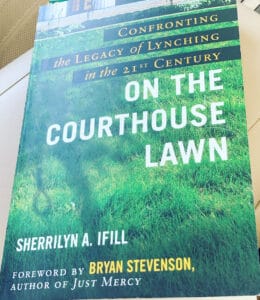
Lynching On the Courthouse Lawn
It’s a hard topic to write about, lynching. This stream of violence running through the middle of American history like the great Mississippi flowing down the center of our county is hard to face. But Sherrilyn A. Ifill uses an apt phrase in the introduction to her book, On the Courthouse Lawn: Confronting the Legacy of Lynching in the 21st Century. In talking about the work of South Africa’s Truth and Reconciliation Commission, Ifill says the Commission was, “making the job of forgetting difficult for whites.” That is the job of white Southerners today: we must make it too hard to forget lynching was a normal way of American life.
Why We Remember Lynching
Why would we want to remember lynchings? Because lynching affects the way we in the South live today. Southern whites developed what Ifill calls “regional hyperconsciousness–a deep sensitivity to criticism, especially by outsiders, and a fierce protectiveness of their local institutions, customs and leaders.” If you’re from the South, you recognize that attitude. It’s known colloquially as “Nobody talks bad about Mississippi but me.” Even those who chafe against the injustice of the South don’t want to hear “outsiders” talk about those injustices. The shield of defensiveness helps stopper our white ears when our Black neighbors tell us how they still carry the harm of our past.
Lynching As It Was
Why “on the courthouse lawn”? Because lynchings often took place exactly there: on the lawn of the local symbol of the rule of law. We mostly call lynching “extrajudicial killing.” But as Ifill makes clear, white Americans used the term “lynch law.” Lynching was a type of law unto itself, owned only by whites. Whites sometimes lynched other whites, but the overwhelming bulk of these gory killings were against Black Americans. And often times the mob began by deliberately gathering on the courthouse lawn.
Nor were lynchings secret affairs as invariably portrayed in the movies. They were picnics. Celebrations. Spectacles. Often whites wrapped lynchings inside racist pogroms, fanning out, randomly hunting down Black Americans. Forget the quaint mob scene of To Kill a Mockingbird (as Ifill notes, there is no record of a lynch mob being shamed into dispersing.) Lynchings were vicious, extended, determined huntings. The mob attacked police (when police weren’t cooperating). They attacked judges (when judges weren’t cooperating). They attacked politicians (when politicians weren’t cooperating). Mobs didn’t care if the person they lynched was guilty or not. Hanging any Black American was sufficient to get their point across. Lynchings happened on Sundays. On holidays. On Easter Monday. Parents placed children on the front row and forced them to watch. Yet, when challenged or made to feel shame for their actions, locals laid the blame on “outsiders.” Sound familiar?
The lynching period continued far longer than most of us want to admit. From the end of Reconstruction in 1875 to approximately 1950, lynching consumed the South. But after the events, white silence and forgetting closed around the wound.
The After-Life of Lynching
One of the most important points of Ifill’s book is this: Black folks have not forgotten lynchings. In Ifill’s area of focus—the Eastern Shore of Maryland, birthplace of Frederick Douglass—lynchings live on in local lore. Perhaps they live on in the lore in your town too. But, if you’re white, you don’t know it. Ifill discovered among Black folks a continuing, deep suspicion of whites. Black folks’ employers, coworkers, and town officials attended—and casually mentioned—lynchings. Ordinary white folks, casual about lynchings.
If reminded of their ancestor’s actions, descendants express fierce anger. The most common reaction was to refuse to hear the truth. After all, as long as white folks can deny the truth, its recurrence in the present can be ignored. Tools of Black oppression—Black Codes, Convict Leasing, Lynching, Jim Crow, Mass Incarceration, the War on Drugs. These can morph from one tool to the next to the next. Never going away, just morphing along.
Repairing Lynching Today
How do we “confront the legacy” as the title implies? Truth-telling. Reparations. Reconciliation, in that order. Truth-telling includes remembering that Blacks did not acquiesce in the terror but moved to “strengthen their community.” (Can anyone say Ida B. Wells?) Reparations is “[A] symbolic effort to balance the scales and an articulation of responsibility for the harm done.” Ifill recommends reparations be local, emphasize dialogue, and be viewed expansively. Money, yes, but also re-dedicating violated public spaces. Expunging records of falsely accused Black folks. Teaching the history of lynching in schools. Marking gravesites. The ultimate goal is “constructing a new community” where formerly excluded stories are part of the local fabric.
Mississippi’s Current Status
How does Mississippi stand in this effort? The state held its first annual conference of Southern Truth and Reconciliation at Ole Miss in 2006. But in 2010, we named the new federal courthouse in Jackson after Senator Thad Cochran. In 2005, Cochran couldn’t bring himself to apologize for the senate’s decades-long refusal to pass anti-lynching legislation. Guess Mississippi having the most lynchings in the nation didn’t bother him enough…
My Personal Interest in Lynching History
On a more personal level, in 2014 the Vicksburg National Military Park in conjunction with the Jaqueline House African American Museum hosted programs on the 1874 Vicksburg Massacre that led to the end of Reconstruction in Mississippi. The symposium included a wreath-laying near one location where the incidents occurred. According to the Park’s current Chief of Interpretation, Education and Partnerships, the Service is planning a commemoration for 2024 on the 150th anniversary of the killings. I, who had ancestors involved in the killings after the riots, have put my name on the list of interested parties.
The Surprise
It was a welcome surprise to read the update at the end of Ifill’s book: locals erected a statue of Frederick Douglass in Talbot County. The former slave who became one of America’s most brilliant orators now has a statue “on the courthouse lawn.” In our own state, the town of Greenwood erected a statue to Emmet Till, the young boy who was kidnapped and lynched. Maybe one day, his statue will be not in a park but on the Leflore County Courthouse lawn where his killers were allowed to go free.

confronting lynching, emmet till statue, lynching, lynching in america, on the courthouse lawn, sherrilyn A. Ifill, Vicksburg Massacre
derrick knight
Such an important, if horrific post, for someone like me who had been unaware of the harsh reality – especially the celebratory aspect.
Ellen Morris Prewitt
I do appreciate your reading these posts and commenting. They are tough subjects to write about. I’ve known about the picnicking/celebrating for a while, but Ifill directly refuting To Kill a Mockingbird brought it home to me. What we want to believe vs what actually happened…
Joanne Corey
A (New England) poet friend of mine wrote a poem about a postcard of lynching/picnic that she encountered in a museum. It’s difficult to comprehend how torture and murder became a white community celebration, although the underlying current makes a sick sort of sense to people who can now joke about the attack on Paul Pelosi or the political violence of Jan. 6. It’s terrifying.
Ellen Morris Prewitt
I will never forget walking through the National Civil Rights Museum for the first time and looking at anti-lynching pamphlets. I thought, people had to be convinced lynching was BAD? Our enjoyment of violence—including an attack on an 80+ year old man, for heavens sake—is so raw and ugly.
terry woosley
The Legacy Memorial/Museum in Montgomery, AL is a powerful experience of our tragic history. Very powerful The Equal Justice Initiative is offering free admission on MLK weekend 2023.
Ellen Morris Prewitt
Good to hear from you. Yes, I must get down to the EJI memorial. We were scheduled to go once, but had to cancel at the last minute. I’ve not heard from anyone who hasn’t come away affected. And to do it on MLK weekend…thank you for letting me know!
Marie Bailey
Thank you for this review, Ellen. Since I’m married to a white Southern (by birth, anyway; both of us still consider ourselves Californians at heart) and have lived in the South for 30+ years, I’m more versed in our sordid history with lynching than my northeastern education ever prepared me for. We should forget our lynching history no more than we should forget the Holocaust–although, sadly, some people think we should forget that too. I guess no one likes to be reminded of how base and cruel we are capable of being.
I used to have a book–Without Sanctuary, photographs of lynchings across the US. Some of those lynchings occurred as late as the 1960s, I believe. I’m not sure if I still have the book. I’ll have to look. It’s a hard book, full of photographs that are difficult if not impossible to unsee once you’ve seen them. Picnics, indeed. Sometimes people would take pictures and make postcards out of them. At one time I thought about sending the book to Jeb Bush, while he was governor of Florida and after he made a comment to the effect that slavery was long over and lynchings were ancient history. I wanted him to know that lynchings were likely still occurring when he was a young adult.
Ellen Morris Prewitt
Goodness, Marie. How hard that book would be to read. I know that in Mississippi, the last lynching considered part of the lynching era occurred in 1950, after my husband was born. It is incredibly recent history, but, as you say, we shove it into the distant past. It’s so gruesome, we really don’t want to admit it was standard practice in fairly modern America.
Michael Van Hecke
In the NC US Senate race, the Democrat Cheri Beasley is a former NC Supreme Court justice. She is experienced, brilliant, and happens to be black. Republican Ted Budd has little if any issue ads; instead, he has chosen to fear-monger. Despite his own bankruptcy, he tells us to fear what might happen in Beasley is elected. I am stunned to see that polls have Budd leading with white women when voluntary termination of pregnancy may soon be only a former right of privacy.
Ellen Morris Prewitt
“White women are under acknowledged as perpetrators and perpetuators of racial violence.” This is my new mantra. And that racial fear can be used against us even when the candidate is a female former justice, well, that just speaks volumes. I often think I’m glad Daddy didn’t live to see some of what happened to his North Carolina. 🙁